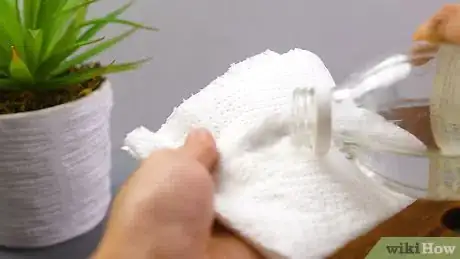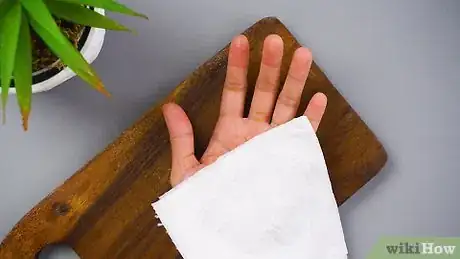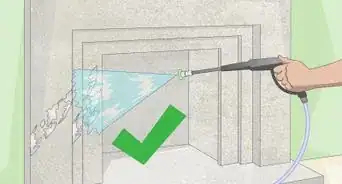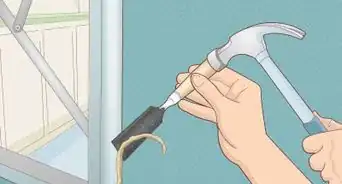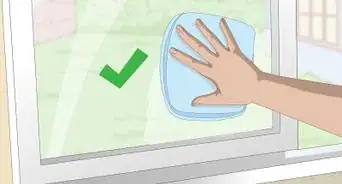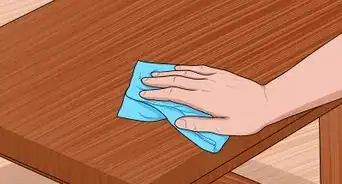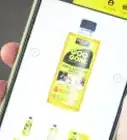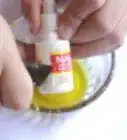This article was co-authored by wikiHow Staff. Our trained team of editors and researchers validate articles for accuracy and comprehensiveness. wikiHow's Content Management Team carefully monitors the work from our editorial staff to ensure that each article is backed by trusted research and meets our high quality standards.
There are 10 references cited in this article, which can be found at the bottom of the page.
The wikiHow Video Team also followed the article's instructions and verified that they work.
This article has been viewed 14,478 times.
Learn more...
Epoxy is an industrial-strength adhesive that has so many uses you would be missing out if you didn’t keep some around your home. Although it’s non-toxic, it’s also very strong and dries out quickly, which means that it's easy for epoxy to get stuck on your skin. Even with the best protection and an accessible sink, you may still end up with epoxy glue residue that is difficult to remove. Fortunately, there are multiple easy ways you can remove epoxy glue from your skin. Use any of the methods below to get epoxy off of your hands.
Steps
Soaking with Vinegar
-
1Soak a paper towel in any type of vinegar. Use whatever type of vinegar you have available. Pour it directly onto the paper towel until it’s soaked. Doing this can make a bit of a mess, so try doing it over your sink. Alternatively, pour the vinegar into a bowl, then drop the paper towel into it.[1]
- If you don't have vinegar, use isopropyl alcohol instead.
- You could also use a regular cloth. For example, dampen a small dishcloth that you can drape over your hand.
- Vinegar is a great choice for epoxy since you’re likely to have it on hand and it’s completely natural. Unlike with other treatments, you won’t have to worry about exposing your skin to harsh chemicals.
-
2Cover the epoxy with the paper towel for 5 minutes. Place the towel on your hand, spreading it as flat as possible. Make sure the epoxy is completely covered. The vinegar will soak into it and soften it. If the towel dries out while you’re waiting, apply a little more vinegar to it.[2]
- Vinegar works on both cured and uncured epoxy, but it’s best used when the epoxy is fresh.
Advertisement -
3Scrub your hand gently with the towel to remove the glue. Vinegar causes the glue to peel away from your skin, making it much easier to remove. Take the damp towel and rub it on your skin in a circle. Keep working until your hand feels clean again. Check afterward for any remaining spots you might have missed.[3]
- If you notice some small fragments of glue left, peel them off by hand. Dampen the glue with vinegar again if it feels hard or difficult to remove.
-
4Wash your hands with soap and water to remove glue residue and vinegar. Place some dish soap on your palm, then rub your hands together for about 20 seconds. Make sure you pay extra attention to the spots where the glue was. Rinse the soap off afterward with warm water. The vinegar won’t harm you if you leave it on your skin, but washing your hands rinses off any leftover glue you might have overlooked.[4]
- Once you’re done, you can rub a moisturizing hand sanitizer into your skin if it feels a little raw.
Cleaning off with Acetone
-
1Work in a well-ventilated area when using acetone. Acetone is somewhat unpleasant to breathe in, so take any safety precautions you can. Work outdoors or in an area with plenty of air circulation, if possible. You can open nearby doors and windows to get more air into the room if you’re indoors.[5]
- Acetone isn’t too bad in small quantities, so you won’t need to wear a mask. It is safe as long as you use it as intended. Acetone is also flammable, so keep it away from open flames.
- For the best result, use 100% acetone. Many nail polish removers and even paint thinners have acetone. If they aren’t 100%, they can still be used, but may not be as effective or safe.
- If you don’t have acetone available, try using rubbing alcohol instead.[6]
-
2Dampen a cotton bud in acetone. Open the bottle, then pour some of the acetone onto the cotton bud. Make sure it’s moist but not dripping. Shake out the excess over your sink or into a trash bag so it doesn’t drip onto your skin.[7]
- If you don’t have cotton buds at home, get a paper towel instead. Dampen a small section of it, enough to rub onto the glue.
- Try to avoid getting acetone over the rest of your hands. If you do, wipe it off with a damp rag so your skin doesn’t dry out.
-
3Wipe your skin in a circle to remove the epoxy. Work the acetone into the epoxy until it comes off. If it has dried already, it will take a few minutes to soften. Keep the cotton swab pressed down lightly while rubbing it against your skin.[8]
- Be gentle when scrubbing your hand. Acetone dries out skin, so try to avoid getting it anywhere else but on the epoxy.
- If you’re unable to remove the glue by scrubbing it, you can leave a damp cotton swab or paper towel over it. Let it soak until it softens, then peel it off.
-
4Wash your hands off with soap and water to remove the acetone. Wet your hands under warm water to rinse off the acetone first. Then, add a squirt of hand soap and rub your hands together for about 20 seconds to work it into a lather. Rinse it off afterward. Make sure you fully clean any areas of your skin that came into contact with the acetone.[9]
- Since acetone dries out skin, you could also apply hand lotion to heal from all of the scrubbing you did.
Applying a Waterless Hand Cleaner
-
1Choose an industrial hand cleaner designed to eliminate grease. These cleaners are available online and at some hardware stores. They are similar to regular hand soaps but more abrasive and effective. If you’re able to find one specifically with citrus, it will cut through hardened epoxy very quickly. It’s also much softer on your hands than anything else you could use.[10]
- Unless you fix cars or work in industry, you’re unlikely to have some hand cleaner at home. It’s a good idea to keep a bottle of it on hand if you use epoxy often.
- Regular soap and hand sanitizers aren’t the same as waterless cleaners, so they won’t work.
-
2Pour a small amount of the cleaner onto a soft cloth. Choose a soft cloth big enough to cover the part of your hand with epoxy on it. Dampen it lightly, then shake out the excess moisture. Make sure the damp spot is large enough for you to use while scrubbing off the epoxy.[11]
- If you don’t have a towel handy, you could also pour some of the cleaner directly onto your hand. You can also try using a paper towel, but it might fall apart if you apply too much of the cleaner.
-
3Scrub your hand with the towel for up to 5 minutes. Place the towel on your hand, keeping it covered by the cleaner. Move it across the epoxy in a circle. Be gentle and hold the towel down with a minimal amount of force. You will eventually feel the epoxy soften and either break off or loosen enough that you can peel it off.[12]
- Sometimes you will have to scrub a little longer than you expect. Keep the towel damp so the hand cleaner soaks into the glue.
-
4Rinse off the cleaner and remaining epoxy with warm water. Wash your hands in a sink. Waterless hand cleaners are a little abrasive, so make sure you remove all of it. Then, check to see that the epoxy is gone. If it isn’t, it may have been loosened enough for you to finish peeling off.[13]
- If you’re still having a hard time removing leftover bits of glue, treat it with a little more of the hand cleaner. Scrub it off with a dampened cloth.
-
5Apply hand lotion to your skin to restore it. Your skin will feel a little raw from the abrasive stuff in the cleaner. To fix it, squirt a dollop of your favorite lotion onto your hand. Rub your hands together for about 20 seconds to work it into a lather. Make sure the lotion covers any areas that came into contact with the cleaner.[14]
- Always apply moisturizer after using a waterless hand cleaner. The cleaner is abrasive, although it usually doesn’t dry out skin or leave a nasty smell.
Things You’ll Need
Soaking with Vinegar
- Any type of vinegar
- Soft cloth or paper towel
- Hand soap
- Sink
Cleaning off with Acetone
- Acetone
- Cotton swab or paper towel
- Hand soap
- Sink
Applying a Waterless Hand Cleaner
- Citrus-based waterless hand cleaner
- Soft cloth
- Hand lotion
- Sink
References
- ↑ https://www.youtube.com/watch?v=K8ctaMVYvtU&feature=youtu.be&t=149
- ↑ https://www.bobvila.com/articles/how-to-remove-epoxy/
- ↑ https://www.youtube.com/watch?v=rg04x5vvRF4&feature=youtu.be&t=36
- ↑ https://www.cdph.ca.gov/Programs/CCDPHP/DEODC/OHB/HESIS/CDPH%20Document%20Library/epoxy.pdf
- ↑ https://wonder.cdc.gov/wonder/prevguid/p0000467/p0000467.asp
- ↑ https://www.youtube.com/watch?v=YxXiB6VVKZ8&feature=youtu.be&t=28
- ↑ https://www.ncbi.nlm.nih.gov/pubmed/29483724
- ↑ https://www.bobvila.com/articles/how-to-remove-epoxy/
- ↑ https://www.cdph.ca.gov/Programs/CCDPHP/DEODC/OHB/HESIS/CDPH%20Document%20Library/epoxy.pdf
- ↑ https://www.bobvila.com/articles/how-to-remove-epoxy/
- ↑ https://www.bobvila.com/articles/how-to-remove-epoxy/
- ↑ https://dailymed.nlm.nih.gov/dailymed/drugInfo.cfm?setid=9d0d67bd-b0c4-4620-8719-93544201fa9b
- ↑ https://www.cdph.ca.gov/Programs/CCDPHP/DEODC/OHB/HESIS/CDPH%20Document%20Library/epoxy.pdf
- ↑ https://www.cdph.ca.gov/Programs/CCDPHP/DEODC/OHB/HESIS/CDPH%20Document%20Library/epoxy.pdf
- ↑ https://www.cdc.gov/niosh/docs/2011-199/pdfs/2011-199.pdf
- ↑ http://nmt.edu/academics/mtls/faculty/mccoy/docs2/chemistry/DowEpoxyResins.pdf
